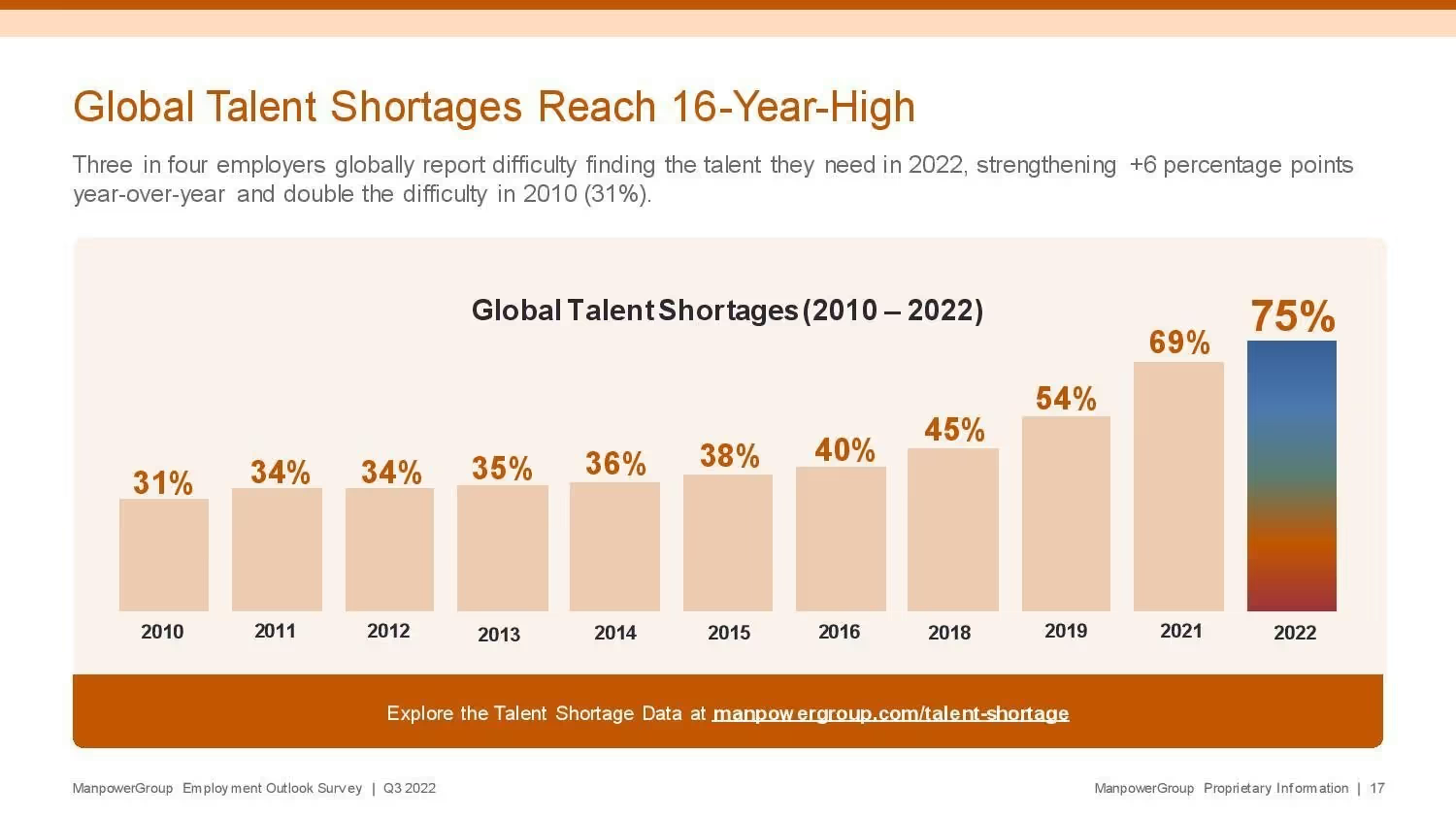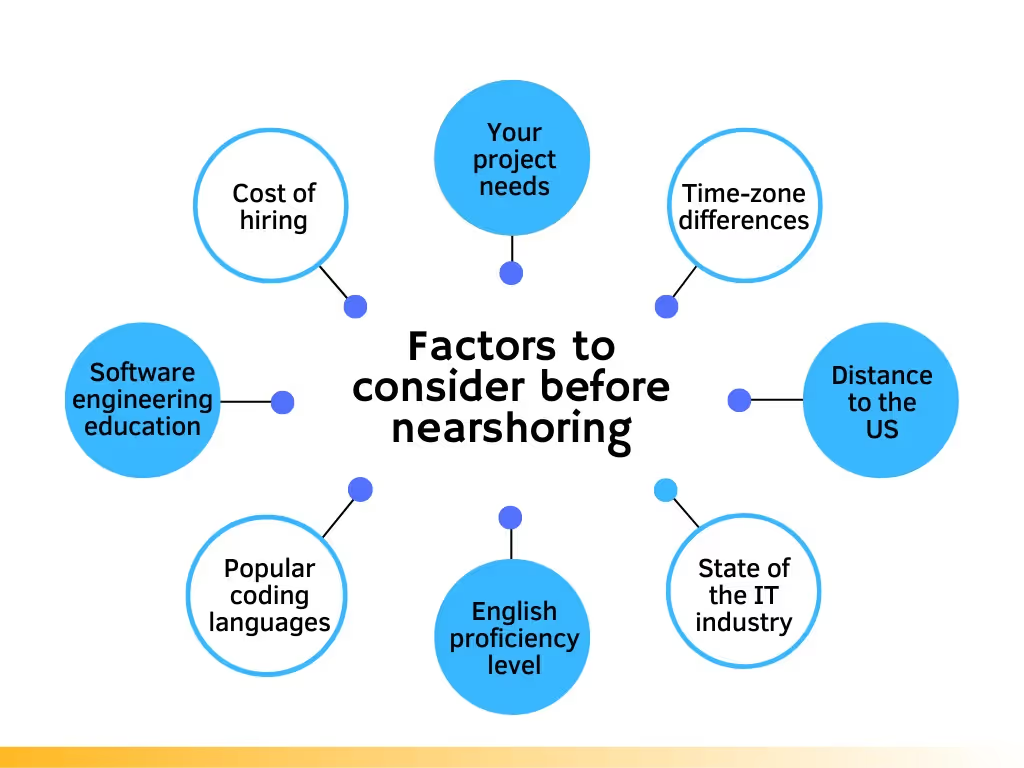Are you looking to start nearshore software outsourcing to the Latin American region? Hiring nearshore developers from Latin America will allow you to reduce development costs and incorporate a more diverse workforce into your team. In our new article, we share with you the ultimate guide to everything you need to know before choosing a Latin American country to hire nearshore developers. There's a lot to cover, so let’s get straight into the ABC of outsourcing to Latin America!


Are you looking to start nearshore software outsourcing to the Latin American region? At Blue Coding, we recommend nearshoring as the most efficient and cost-effective way to start software outsourcing. Hiring nearshore developers from Latin America will allow you to reduce development costs and incorporate a more diverse workforce into your team. But there are many countries to choose from and it can be tough to know where to start. Lucky for you, we have created the ultimate guide with everything you need to know before choosing a Latin American country to hire nearshore developers. There's a lot to cover, so let’s get straight into the ABC of outsourcing to Latin America!

Nearshore software outsourcing refers to hiring foreign development talent in countries that have close proximity to the US and possess limited or nonexistent time zone differences. Compared to offshore outsourcing, where one hires developers from distant foreign countries like India or Pakistan, nearshoring provides companies with affordable developers without having to sacrifice project efficiency and cultural/time zone affinity. A good example of this would be hiring developers in Argentina, where the time zone differences to the EST schedule range between one and two hours, and there are many direct flights to the States per week.
Nearshore software outsourcing provides your company with fully vetted IT professionals within a reduced timeframe. This process allows your company to hire previously vetted expert remote developers as independent contractors, for as long as you need them in your team. It gives you the flexibility to part ways without any paperwork or tricky situations in case there are no other projects you want them to work on. No tough goodbyes here, nearshore development allows you to part ways with developers whenever a project is ready. With a larger talent pool to choose from, nearshoring offers a quick expansion of your in-house team to access top coding solutions made easy.
Did you know remote nearshore developers charge lower rates than local candidates? Hiring nearshore developers in Latin America has a lesser impact on your company’s budget compared to hiring full-time developers. We’re talking about a 30% to 40% cost decrease! This is thanks to the lower costs of IT staff augmentation compared to an in-house recruitment process, the reduced expenses of hiring developers as independent contractors, and the candidates’ cheaper rates due to the lower costs of living that many of them have back in their home countries. With nearshore outsourcing to Latin America, your company can reduce software development costs while fairly compensating your extended team for every development project they work on.
One of the best things about software nearshoring is the shorter timeframes when it comes to the recruitment process. Nearshore software outsourcing has different interview procedures than traditional in-house recruitment. And the typical in-house process comes at a hefty cost! In fact, the Society of Human Resource Management shared in a recent survey that the average cost per hire of traditional recruitment is just over $4,000. Not only is in-house recruitment more expensive, but it’s also an overall longer procedure. If you’re clear about what coding solutions your company needs, you can hire previously vetted IT professionals in as little as two weeks.
Besides the shorter process, nearshore software outsourcing provides your company with the right amount of staff flexibility. If you have a development project in the pipeline right now but are still debating whether or not it’s worth hiring full-time salaried staff for it, then flexibility is what you need. When you hire nearshore developers from Latin America, your company is in full control of contract duration. You can hire expert developers for as long as you need them and let them go in a risk-free way or even choose to add more members to the outsourced team if the project needs to increase over time.

(Manpower Group Talent Shortage Report)
Hiring nearshore software developers in Latin America opens the door to a massive talent pool composed of thousands of developers from different countries. Compared to the limited US-based development talent pool, this is a huge opportunity to find new candidates. While several companies are still hesitant against outsourcing, a recent CNBC report shed light on how the US has nearly 1 million open IT jobs - a number that shows just how much talent is lacking right now. With a 75% US talent Shortage, according to Manpower Group, this is the perfect time to expand your company’s options and try nearshore software outsourcing!
Not only is the talent pool larger, but nearshoring also offers outsourced IT professionals that have minimal time zone and culture barriers. Because Latin America is quite close to the US, the time zone differences to the EST schedule never exceed 4 to 5 hours. Moreover, English education is important in this region and you’ll find all the nearshore developers agencies work with have a strong command of the language and are familiarized with the North American corporate work practices.
Knowing potential nearshoring candidates are just as excited as you about a partnership can help you affirm nearshore software outsourcing is the best choice for your company. Let’s hear from some of the developers in our network about why they love working with North American organizations!
Working remotely in the development field while living in Paraguay and working for a Canada-based company has allowed me not only to earn more money, which, to be fair, is the reason why anyone works, but it has also helped me improve my English (my third language!) and get to know a bunch of excellent developers from around the world.
With the increase in my income, I can start some savings and, promptly, buy my very own first piece of land and start planning what to do with it; instead of just dreaming of doing it, I’ll do it. Also, the remote setup allows me to stay home and watch my firstborn child grow, and help with the diapers and such. Last but not least, I don’t have to commute to get anywhere. I just have to wake up, make my breakfast, think about doing some exercise and not actually doing it (but I plan to start someday), and get to work on the assignment for the day.
Currently, I have about 5 years of experience working in Latin America and the Caribbean for North American companies, and as in any business there are pros and cons:
Pros:
- Competitive Salaries: It is not a mystery that half of a normal salary in North America is a salary that provides a quality lifestyle in Latin America, therefore is attractive for the employer and employee, resulting in a win-win situation.
- Culture: Although not for everyone, the exchange of culture is a unique and enriching experience, being able to discover cultures different from your own is rewarding, and if you are working while doing it, is even better.
- Learning opportunities: This will lead to new opportunities and professional growth
- Remote Work: Working from home is a huge benefit because, being well managed, it can provide more family and personal time, therefore, a better life. A happy employee is a productive employee.
Cons:
- Culture: Yes, also here. Because while it is true that sharing cultures is fascinating, a word or a gesture interpreted incorrectly can lead to an undesired outcome.
The short experience that I have had working for an American Company begins with my arrival in the Dominican Republic 4 years ago. From the beginning of the hiring process until the moment I was onboarded into the team, every detail has been a new experience. The interview process is quite different from what I was used to, with additional questions, goals, and metrics. I had to learn and adapt the way I communicate, using specific terms and gestures to make a sale or save one. In other cases, it was to collect payment or offer financial assistance. It was a challenge since I knew nothing about the business, there were stressful situations and high-quality results were expected within 30 days. The pros were the fact that even though we were working for an American company we still benefit from Dominican labor law (Christmas Bonus, Insurance, PTO) including the commissions I was earning from collecting due payments or sales. We were making a fair amount of money with commissions.
This opened the doors for better living conditions for my family. Working for an American Company showed me that I was able to earn a better salary rate than most by having proper training and a specific set of skills.
Working with US companies has been a very positive experience. Their organization and that kind of workflow make things much easier and more fluid. The salary, compared to what LATAM companies pay, is way higher, allowing us developers to feel more relaxed about financial stability.
Pros:
Cons:
Pros:
Cons:
Cultural exchange is invaluable. You get to learn from other people, which I know sounds cliche but is still one of the biggest advantages in my opinion. I've learned a lot from people in the US, from technical knowledge to business skills. Plus, software development is better appreciated by US Companies, I can tell from my experience as a software developer and as someone that has also tried to run a local software consulting company.
Even though our time zones are pretty similar I saw the different schedules as a disadvantage sometimes, especially when working with people on PST hours.
What I'd say is the biggest challenge about working with US companies is having to keep up with their pace. Things usually move really quickly, I mean, companies growing fast, requirements changing, and with that, the need for more and more talented developers. As developers, we need to keep learning and keep acquiring experience so we remain competitive. This is also what I like the most about the IT industry, the fact that there's always something that keeps pushing you forward. It's a lifetime learning experience.
Pros:
Cons:
Challenges:
After all this, my favorite part is definitely the ability to see the world from the eyes of others. From the companies -that take very different approaches from the local ones to solve most issues, to the colleagues that are from very diverse cultures and places. All this makes my work experience very fulfilling while also leaving space for all the other important things in my life. I can't stop feeling grateful for how blessed I am.
For me, the pros of working for a North American company are:
Compared to many offshore locations, Latin America has minimal time zone differences from the United States. The majority of the countries are only one or a couple of hours ahead of the EDT and EST schedules, making it easy for your entire augmented team to work within your company’s business hours. Moreover, Latin American professionals are taught the importance of mastering the English language from a young age. As a result, most developers from Latin America have excellent English skills and don’t experience any cultural barriers due to the similar corporate culture.
Offshoring might be cheaper in some cases, but nearshore software outsourcing brings the best of the best in terms of physical distance to the US. From neighboring Mexico to Southern Argentina, you’re always just a few hours away from these top nearshoring locations. This is a huge factor in why several US companies choose to hire nearshore developers from Latin America.
Latin America has been positioning itself as a top tech destination for software outsourcing thanks to its IT industry growth. While, as happened to most countries, 2020 slowed down all operations, growth in the region rebounded to an estimated 6.8 percent during the past year. Latin America is still growing, and now it’s an excellent time to insert your business operations into this economy and partner with local professionals while the demand is yet to be at its highest peak.
Global employment organizations allow you to hire developers through their local affiliations, imposing a lot of intervention on their end. There are many GEOs depending on which Latin American countries you’re looking to hire nearshore developers from, just be ready to deal with a heavily present third party. These local companies usually charge the total cost of the nearshore developers’ salary, the cost of benefits, and a fee of 20% or more for their services.
Freelancing platforms help companies find professionals from all over the world who offer their services via remote, independent work. Right now, Upwork and Freelancer are the two most popular freelancing platforms out there. While they might boast developers at extremely cheap prices, they often make it complicated to judge a developer’s expertise and English level before hiring their services and also get a cut of the freelancer’s salary. That’s why we recommend these Upwork alternatives for those looking to start nearshore software outsourcing!
We consider working with a direct contractor to be the most straightforward approach to nearshoring. This way you can hire developers in Latin America without needing to interact with any third parties and can just sort things on your own. It’s a good option for those who’ve dealt with freelancers before and know exactly the type of development work they need. Though it can take a longer time to find the perfect candidate without any external help, a good place to start is the top tech events in Latin America to find developers.
Partnering up with an agency that specializes in nearshore software development services is the safest bet when nearshore software outsourcing. This is the best way to obtain extensive hiring knowledge about the local market and find developers quicker than you would on your own. At Blue Coding, we carefully vet all Latin American developers and hire the right IT professionals depending on your project’s specific needs.


When it comes to time zone differences, Argentina is really at the top of the list. This South American country is in the GMT-3 schedule and is only 1 to 2 hours ahead of the EST time zone. During EDT (Spring and Summer), Argentina is 1 hour ahead of the States, while during EST (Fall and Winter) Argentina is 2 hours ahead.
The distance from Argentina to The United States is 8,986 kilometers or 5,584 miles. You can travel to Argentina by airplane and it takes approximately 9.97 hours, depending on where you depart from.
Argentina, the land of dulce de leche, beautiful tangos, and outstanding football players, such as the one and only Lionel Messi. Besides the country’s clear highlights, there’s a reason nearshore software developers in Argentina are so sought after. The software development industry in this country has been booming since the ’90s and in recent years it has become a technological hub in Latin America. According to the CESSI (Argentine Chamber of the Software Industry), software development in Argentina has seen a steady growth of 50% Argentine software engineers and 36% tech companies in the past few years.
These statistics show how the industry keeps growing and becoming more active in the country, with thousands of people choosing web development as a career each year, but there’s more. . As if these numbers weren’t looking up on their own, Argentina ranked as the #1 country with software engineering skills worldwide in 2019 when Coursera’s 2019 Global Skills Index showed them as the leaders in technological and web development skills.
Argentina is actually the Latin American country with the highest level of English proficiency. According to the EF English Proficiency Index 2021, Argentina ranks first with a score of 556 out of a maximum of 800 points. The global ranking is also high, with the country scoring 30th.
The most popular programming languages with developers from Argentina are
Argentina has long become an international hub for learning, thanks to its affordable and highly-ranked universities and other institutions. To this day, the country offers 38 different undergraduate degrees and professional certificates in software development and coding. Furthermore, the CFE (Federal Council of Education) dictated back in 2018 that by 2020, all secondary schools needed to prioritize robotics and coding content in their educational curricula. This shows the intention to move towards an even more prominent programming scene in the country. Pair this new regulation with the many coding learning institutions available, and it’s not hard to see a future where Argentine software engineers become even more in demand
Argentina’s economic issues and the peso’s conversion to US dollars make the salaries of Argentine software engineers up to 75% lower than in the United States. Meaning the cost of software development in Argentina is much more attainable than in the US or even in other parts of Latin America. This is great news for US tech companies looking to nearshore software developers and part of what makes Argentina a top nearshore outsourcing destination.
Keep in mind that staff augmentation firms will charge an additional fee of about 20% to 30% of the developer’s salary in compensation for their work of finding the right IT professional for your organization.

Just like the US, Mexico has several different time zones. But the most prominent time zone for developers in the Latin American country is that of Mexico City. Lucky for companies looking to start nearshore software outsourcing, Mexico City is only one hour ahead of the EST time zone.
Mexico is the closest Latin American country to the US! There’s a 1,954 miles (3,145 km) border between the United States and Mexico separating the two countries as they’re right next to each other. There are 48 U.S.–Mexico border crossings, with 330 ports of entry, but flying to the Latin American country is also another option.
Mexico is home to many top software engineering firms, ranging from small and well-known consultancies like Codebay and Teravision to large multinationals like Oracle. Mexico is also home to large financial institutions like BBVA, Santander, and HSBC Mexico. These have strong software engineering divisions, and many software engineers in Mexico work with financial institutions at some point in their careers.
Besides having more than 223,398 developers, Mexico is among the world’s emerging software exporting nations. Its proximity to the United States and the large number of bilingual professionals living there has made this country not only thrive within the IT sector but also an attractive nearshoring hub.
When it comes to English proficiency level, Mexico suffers from a considerable disparity in language education. While there are many bilingual IT professionals, especially those residing in Mexico City and the country’s other tech hubs, the majority of the local population doesn’t have a good English level. This is why Mexico ranks 92 out of 112 countries in the EF English Proficiency report, with a score of 436, and ranks second-to-last in Latin America.
Among the top languages and technologies used by developers in Mexico are:
Mexico has approximately 1250 public and private universities across the country, providing a steady stream of well-educated software engineers. Some of Mexico’s top universities for computer science and similar degrees are the Centro de Enseñanza Técnica y Superior (CETYS University), Universidad Anáhuac Mayab, the Technological University of Leon, and Gauss Jordan Specialized Institute in Computer Science and Administration (which also provides students with valuable insight on business organization and administration).
Due to the high demand for talented software engineers, it is not uncommon to find top engineers in Mexico asking for salaries comparable to some areas of the US. For remote companies looking to hire in Mexico, these ranges will give you an idea of how much to pay experienced developers with high English levels:
Keep in mind that staff augmentation firms will charge an additional fee of about 20% to 30% of the developer’s salary in compensation for their work of finding the right IT professional for your organization.

Uruguay is one hour ahead of the EDT schedule, and two hours ahead of the EST time zone. Depending on the time of the year, the difference will vary but is never more than two hours from Eastern Standard Time.
The distance from the United States to Uruguay is 8,753 kilometers or 5,439 miles. You can travel between the two countries via airplane, which takes 9.71 hours to arrive.
Uruguay’s IT industry has experienced significant growth over the past few years, turning into a reliable nearshoring hub for IT professionals. This is a country with an advanced technical background and a promising future for IT professionals. In fact, Uruguay is currently the number 1 software exporter per capita within the South American region and is often called the Silicon Valley of South America. The government favors IT companies, with measures such as 100% tax exemption for tech businesses. Thanks to continuous support, Uruguay now has 700 IT companies that offer high-quality technological solutions to the world and a large number of talented developers ready to work.
According to the 2021 EF English Proficiency Index, Uruguay has a moderate English level. It ranks 53 out of 112 countries worldwide and 8 of 20 within Latin America, with a total score of 509 points.
Most popular programming languages with nearshore developers from Uruguay:
If you’re looking to start nearshore software outsourcing from Uruguay, know that this country is one of the most advanced in Latin America in terms of education. Education is free in Uruguay, including a public university where 11% of its annual enrollment is for software development degrees. Even more, high school is mandatory for all citizens and permanent residents, boosting the country’s literacy rate to a fantastic 98.7%.
Moreover, the One Laptop Per Child structure facilitates free laptops and internet connectivity to all students and teachers in the nation. This initiative is also partnered with Uruguay’s National Administration of Public Education to offer a wide array of computational thinking, robotics, coding classes, and extracurricular subjects available nationwide in order to improve Uruguay’s computer science skills. Because of this and the many higher education institutions specializing in tech and engineering, Uruguayan software engineers are among the most technologically proficient professionals in Latin America.
Because of the favorable US dollar to Uruguayan pesos conversion rate, the expenses of software development can be up to 40% lower than in the United States. By nearshore outsourcing to this region, your business will ensure high-quality deliverables at an attainable cost. Here are the average nearshore developer salaries in Uruguay:
Keep in mind that staff augmentation firms will charge an additional fee of about 20% to 30% of the developer’s salary in compensation for their work of finding the right IT professional for your organization.

Both the United States and Brazil have multiple time zones, but for practical purposes, we’ll list the difference between Brasilia - Federal District and the EST/EDT time zone. Lucky for those looking to start nearshore software outsourcing to Brazil, the time difference between Brasilia and the EST schedule is just one hour.
Brazil is 4546.3 miles away from the United States. This distance is best traveled by flight, which takes 8.1 hours to arrive.
Brazil is home to many top software engineering firms, ranging from small and well-known consultancies like PlataformaTec (acquired in 2020 by NuBank) to multinationals like IBM. Brazil is also home to large financial institutions like Itau Unibanco, Banco Bradesco, and Banco Do Brasil, with strong software engineering divisions, as well as other large companies in other industries. Most software engineers in Brazil are based in the largest cities: São Paulo, Rio de Janeiro, Brasilia, Salvador, Fortaleza, Belo Horizonte, and Manaus, but many live in smaller cities across the country. Because this country has a very large population, its IT industry is constantly evolving and new developers are trained ad start working every year.
Brazil ranks 60 out of 1112 countries on the 2021 EF EPI score, with a low English proficiency level. It scored a total of 497 points and placed 12 out of 20 on the Latin American ranking.
Among the top languages and technologies used by developers in Brazil are:
Brazil has more than 2600 public and private universities across the country, providing an amazing source of software engineering talent. Some of the top universities teaching computer science and related degrees are: Universidade de São Paulo, State University of Campinas, Federal University of Minas Gerais, Federal University of Rio Grande do Sul, and Federal University of Rio de Janeiro. There’s also a huge number of well-established multinationals and large organizations and consulting firms in Brazil with strong software engineering departments that provide developers with a place to polish their skills, as well as the numerous niche software development studios in Brazil.
Top engineers in Brazil command salaries that rival those of their North American peers. For remote companies looking to hire in Brazil, these ranges will give you an idea of how much to pay experienced developers with high English levels:
Keep in mind that staff augmentation firms will charge an additional fee of about 20% to 30% of the developer’s salary in compensation for their work of finding the right IT professional for your organization.
Subscribe to our blog and get the latest articles, insights, and industry updates delivered straight to your inbox